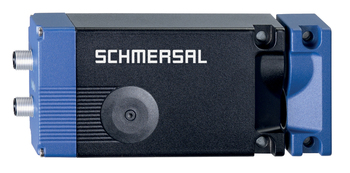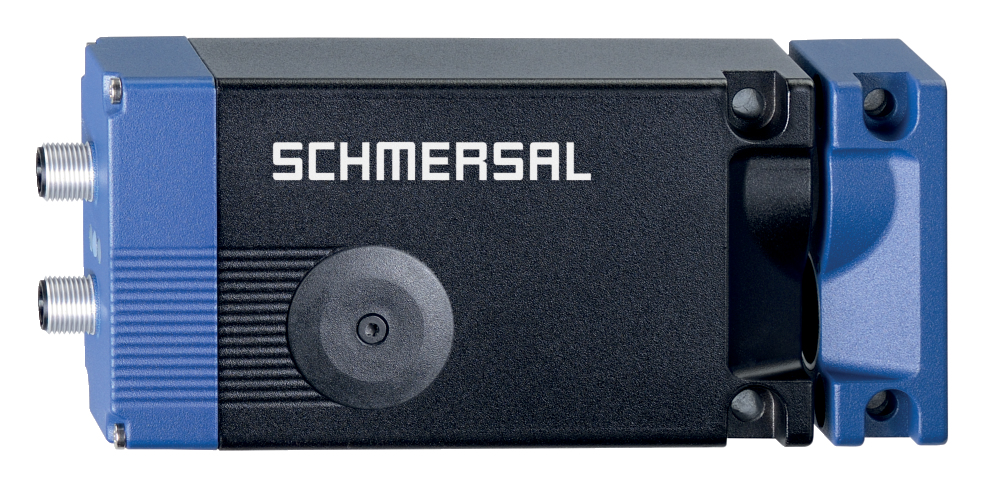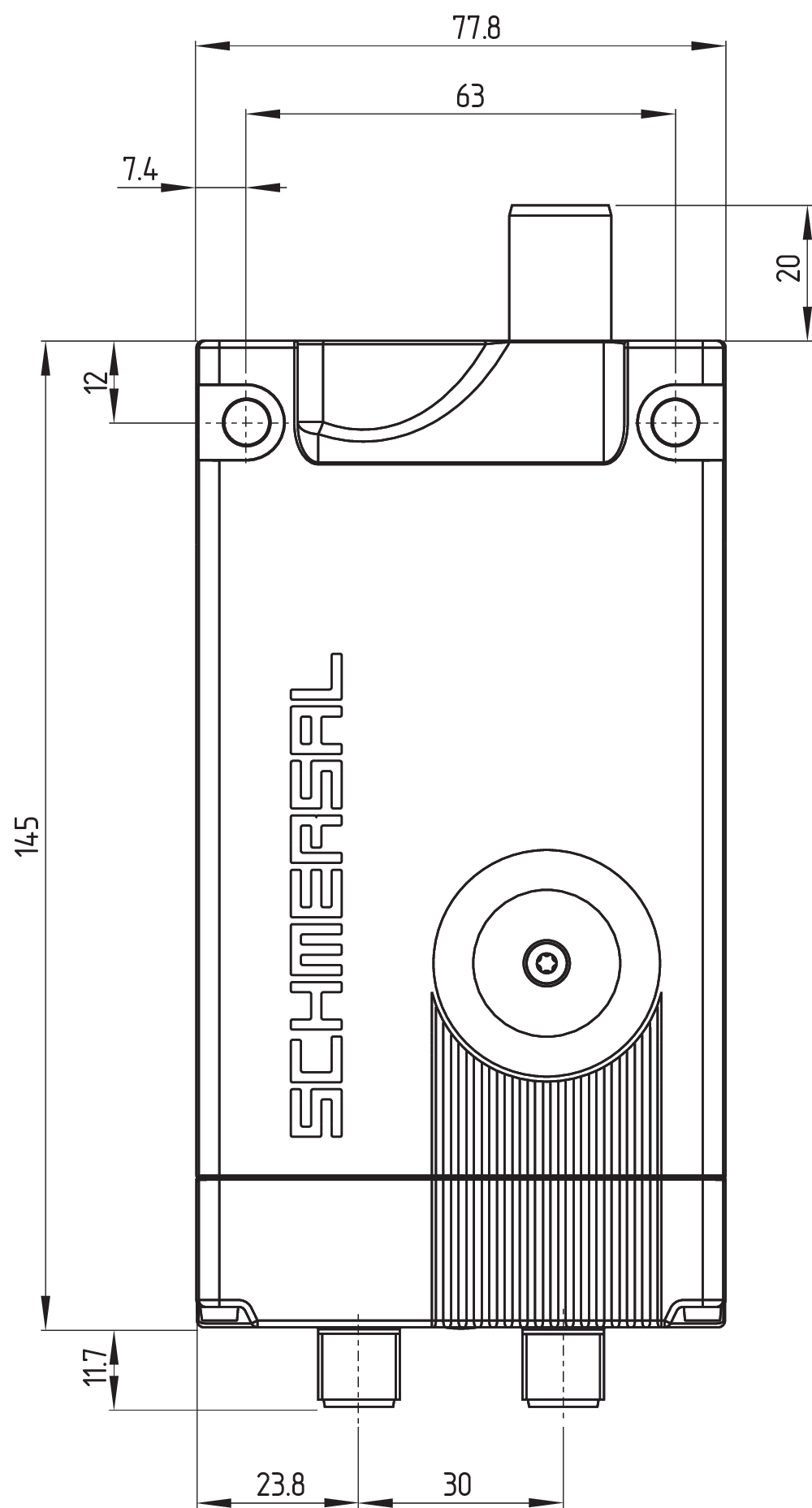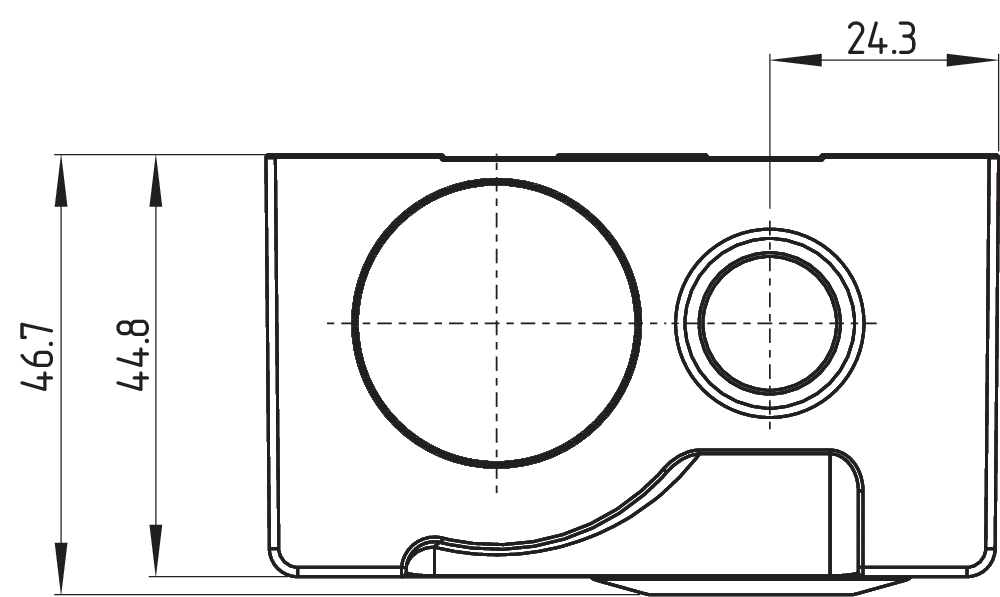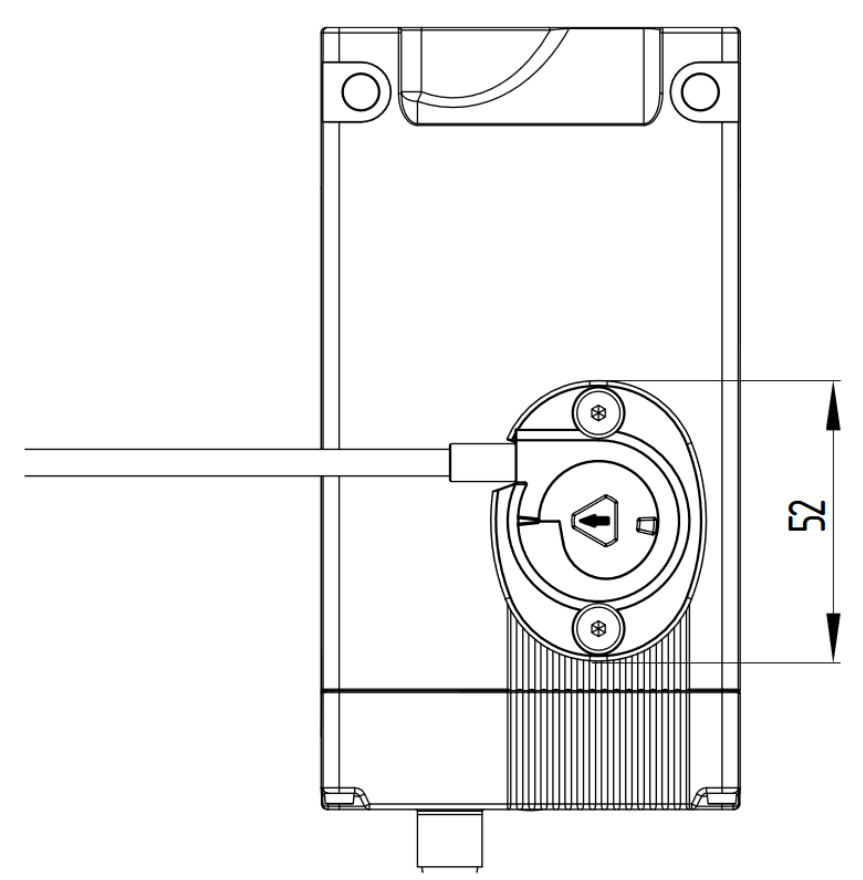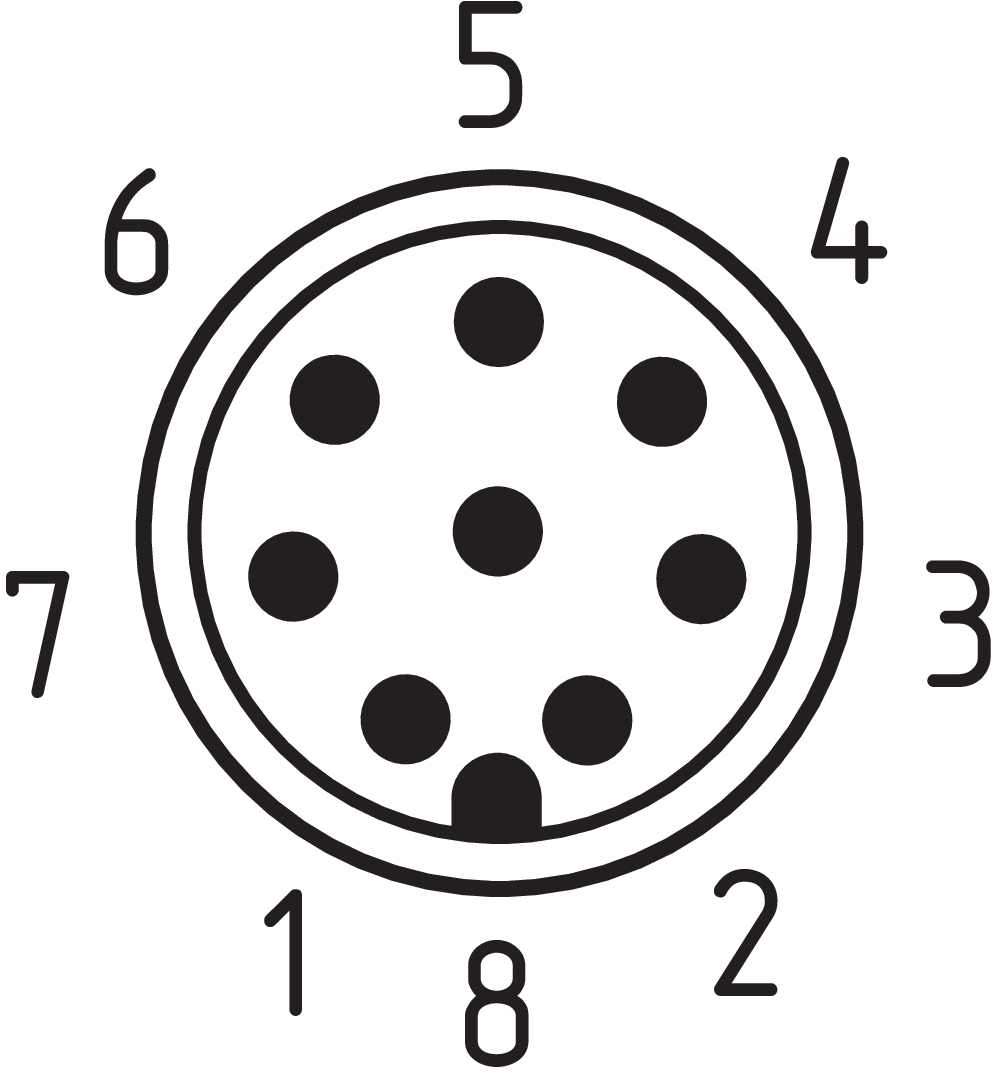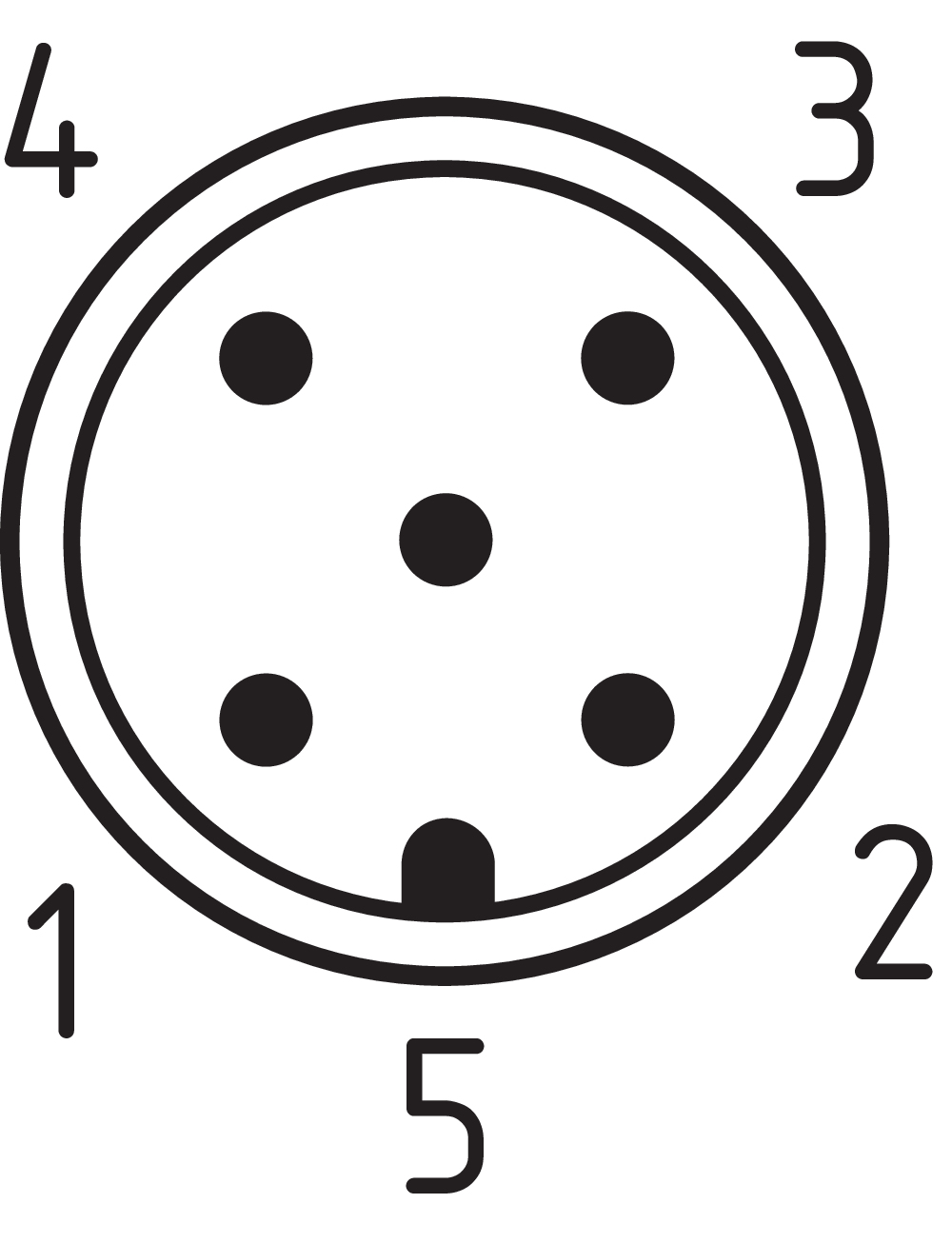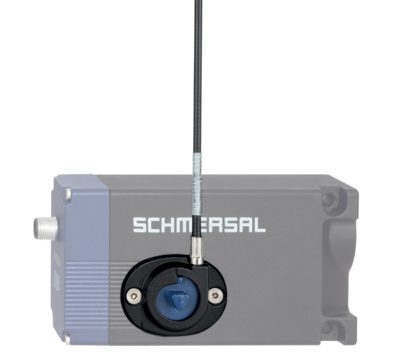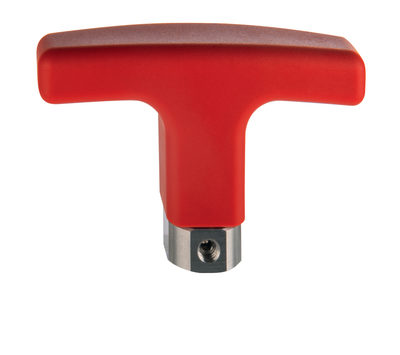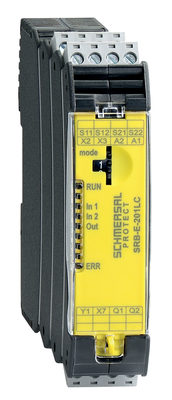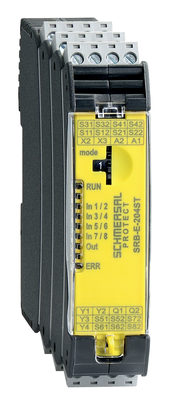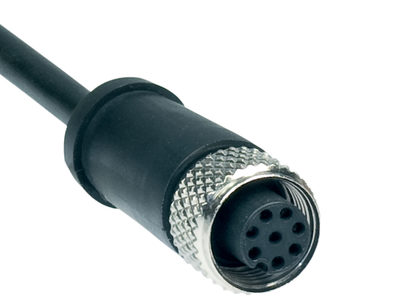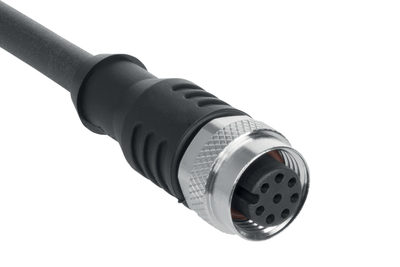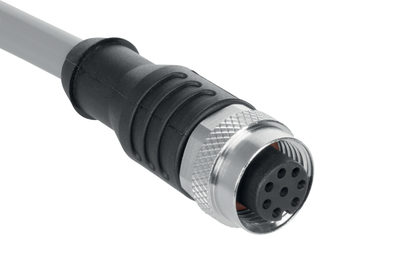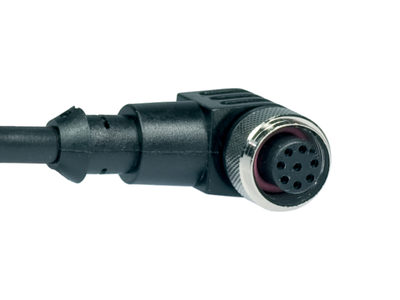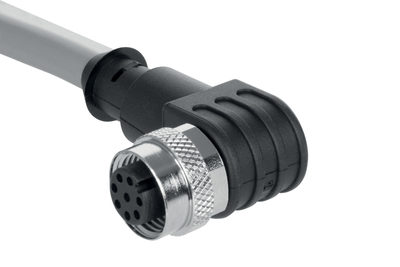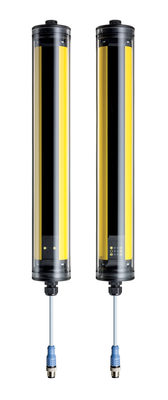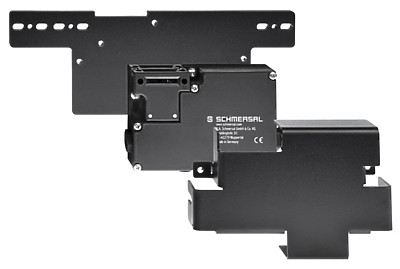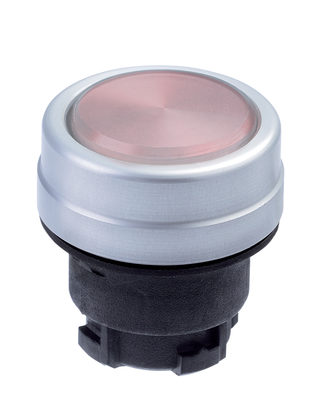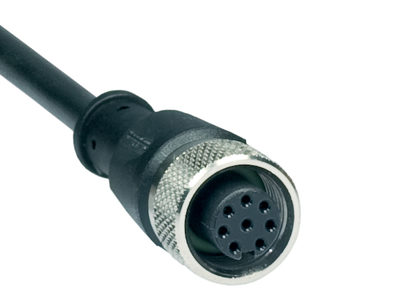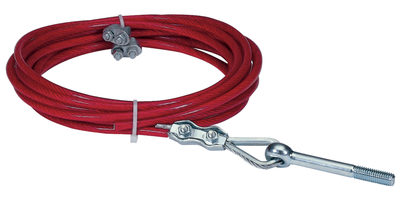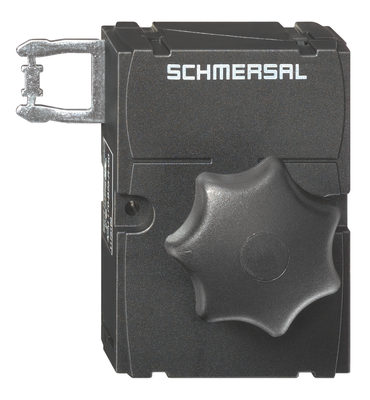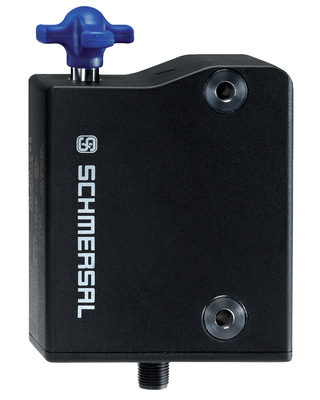AZM400Z-ST2-2P2P-BOW-E
AZM400Z-ST2-2P2P-BOW-E
| Descripción del tipo de producto: AZM400Z-(1)-(2)-(3)-(4)-(5) |
| (1) | |
| ST | 1 conector M12, 8-polos |
| ST2 | 2 conectores empotrables M12, 8-polos / 5-polos |
| (2) | |
| sin | Codificación estándar |
| I1 | Codificación individual |
| I2 | Codificación individual, aprendizajes multiples |
| (3) | |
| 1P2P | 1 salida de diagnóstico y 2 salidas de seguridad, tipo P (sólo para ST) |
| 2P2P | 2 salidas de diagnóstico y 2 salidas de seguridad, tipo P (sólo para ST2) |
| (4) | |
| sin | Rearme manual |
| T | Dispositivo de desbloqueo de emergencia (anti-pánico) |
| BOW | Con taladros de sujeción para montaje con cable Bowden |
| (5) | |
| sin | sin desbloqueo manual electrónico (sólo para ST) |
| E | con desbloqueo manual electrónico (sólo para ST2) |
- Codificación universal con tecnología RFID
- 2 Conector M12, 8- y 5-polos
- Vigilancia del bloqueo
- 2
- Con taladros de sujeción para montaje con cable Bowden
- Desbloqueo manual eléctrico con tensión auxiliar
- Sistema biestable con actuacion motorizada
- Fuerza de bloqueo 10.000 N
- Desbloqueo posible con fuerzas laterales hasta 300N
- PL e / cat. 4 / SIL 3 para funciones de bloqueo y enclavamiento de seguridad
- Control de función de bloqueo mediante dos canales
- Funcionamiento en salidas de tipo P/P y P/N
- Amplia tolerancia del actuador
Detalles de Pedidos
| Descripción del tipo de producto |
AZM400Z-ST2-2P2P-BOW-E |
| Número de artículo (Nº artículo) |
103015312 |
| EAN (European Article Number) |
4030661503998 |
| eCl@ss number, version 12.0 |
27-27-26-03 |
| eCl@ss number, version 11.0 |
27-27-26-03 |
| Número eCl@ss, versión 9.0 |
27-27-26-03 |
| ETIM number, version 7.0 |
EC002593 |
| ETIM number, version 6.0 |
EC002593 |
Aprobaciones - Normas
|
TÜV cULus FCC IC ANATEL |
Propiedades Globales
| Normas |
EN ISO 13849-1 EN ISO 14119 EN IEC 60947-5-3 EN IEC 61508 |
| Información general |
Codificación universal |
| Nivel de codificación según EN ISO 14119 |
baja |
| Principio activo |
Campo magnético RFID |
| Frequency band RFID |
125 kHz |
| Transmitter output RFID, maximum |
-6 dBm |
| Material de la caja |
Aleación ligera inyectada |
| Tiempo de reacción de las salidas de seguridad en caso de desconexión mediante actuador, máximo |
100 ms |
| Peso bruto |
860 g |
Datos generales - Características
| Monitorización del bloqueo |
Sí |
| Desbloqueo manual electrónico |
Sí |
| Detección de cortocircuito |
Sí |
| Detección de cortocircuitos entre hilos |
Sí |
| Taladros de sujeción para montaje con cable Bowden |
Sí |
| Funciones de seguridad |
Sí |
| Indicador integrado, estado |
Sí |
| Número de señales de diagnóstico |
2 |
| Cantidad de contactos de seguridad |
2 |
Certificación de seguridad
| Normas |
EN ISO 13849-1 EN IEC 61508 |
Certificación de seguridad - Función de bloqueo
| Nivel de prestaciones (PL) hasta |
e |
| Categoría de control |
4 |
| Valor PHF |
1,00 x 10⁻⁹ /h |
| Valor de PFD |
9,00 x 10⁻⁵ |
| Safety Integrity Level (SIL), adecuado para aplicaciones en |
3 |
| Vida útil |
20 Año(s) |
Certificación de seguridad - Función de enclavamiento
| Nivel de prestaciones (PL) hasta |
e |
| Categoría de control |
4 |
| Valor PHF |
1,80 x 10⁻⁹ /h |
| Valor de PFD |
1,60 x 10⁻⁴ |
| Safety Integrity Level (SIL), adecuado para aplicaciones en |
3 |
| Vida útil |
20 Año(s) |
Datos mecánicos
| Principio de bloqueo |
bi-estable |
| Vida mecánica, mínima |
1.000.000 Maniobras |
| Nota (vida mecánica) |
De ello con fuerza transversal Ftrans = 100 N: 100.000 maniobras |
| Distancia admisible entre el bloqueo y el actuador, mínima |
1 mm |
| Distancia admisible entre el bloqueo y el actuador, máxima |
7 mm |
| Angular misalignment between solenoid interlock and actuator, maximum |
2 ° |
| Distancia mínima entre dispositivos |
30 mm |
| Fuerza de bloqueo FZh según EN ISO 14119 |
10.000 N |
| Fuerza de bloqueo Fmax, máxima |
13.000 N |
| Fuerza transversal en retroceso de perno, máximo (contra puerta tensada) |
300 N |
| Nota (fuerza transversal durante retroceso de perno) |
Esta información no es aplicable para el desbloqueo de escape, cable Bowden y desbloqueo manual |
| Ejecución de los tornillos de fijación |
2x M6 |
| Indicación (Ejecución de los tornillos de fijación) |
Property class min. 10.9 |
| Par de apriete del tornillo |
8 Nm |
| Par de apriete de los tornillos de sujeción del cable Bowden |
1,2 Nm |
Datos mecánicos - Conexionado
| Conexión conector |
2 connector M12, 8 and 5 pin., both A-coded |
Datos mecánicos - Dimensiones
| Longitud del sensor |
46,7 mm |
| Anchura del sensor |
77,8 mm |
| Altura del sensor |
156,7 mm |
Condiciones ambientales
| Protección |
IP66 IP67 |
| Indicación |
Protection class remains with correctly installed bowden cable release |
| Temperatura ambiente |
-20 ... +55 °C |
| Temperatura de almacén y de transporte |
-40 ... +85 °C |
| Humedad relativa, máxima |
93 % |
| Nota (humedad relativa) |
sin condensación sin escarcha |
| Resistencia a vibraciones |
10 … 150 Hz, amplitud 0,35 mm |
| Resistencia al impacto |
30 g / 11 ms |
| Grado de protección. |
III |
| Altura de montaje snm permitida, máximo |
2.000 m |
Condiciones ambientales - Valores de aislamiento
| Tensión de aislamiento nominal Ui |
32 VDC |
| Resistencia al impulso de sobretensión Uimp |
0,8 kV |
| Categoría de sobre-tensión |
III |
| Grado de polución |
3 |
Datos eléctricos
| Tensión operativa |
24 VDC -15 % / +10 % |
| Alimentación auxiliar Uhe |
24 VDC -15 % / +10 % (UPS / uninterruptable power supply) |
| No-load supply current I0, typical |
100 mA |
| Consumo de corriente durante el movimiento del cerrojo, valor máximo |
600 mA / 100 ms |
| Tensión nominal operativa |
24 VDC |
| Corriente de cortocircuito |
100 A |
| External wire and device fuse rating |
2 A gG |
| Retardo de disponibilidad, máxima |
1.500 ms |
| Frecuencia de conmutación, máxima |
0,3 Hz |
| Ciclo de cierre / apertura, mínimo |
3 s |
| Tiempo de ciclo mínimo medio (en funcionamiento constante) |
20 s |
| Categoría de utilización DC-12 |
24 VDC / 0,05 A |
| Fusibles eléctricos, máximo |
2 A |
Datos eléctricos – Entradas de control
| Denominación, entradas de control |
E1 und E2 (p-schaltend), E3 (n-schaltend) |
| Niveles de conmutación de las entradas de control |
−3 V … 5 V (Low) 15 V … 30 V (High) |
| Clasificación ZVEI CB24I, depresión |
C0 |
| Clasificación ZVEI CB24I, fuente |
C1 C2 C3 |
| Corriente operativa a 24V, Mínima |
5 mA |
| Corriente operativa a 24V, Máxima |
10 mA |
| Tiempo de discrepancia permitido (señal de entrada), máxima |
10 s |
| Periodo de impulso de prueba, máxima |
40 ms |
| Duración de impulso de prueba, máxima |
5 ms |
| Corriente residual permitida del control |
1,5 mA |
Datos eléctricos - Salidas digitales seguras
| Denominación, salidas de seguridad |
Y1 y Y2 |
| Versión |
protegidas contra cortocircuitos, tipo p |
| Caída de tensión Ud, máxima |
2 V |
| Corriente residual Ir, máxima |
0,5 mA |
| Tensión, categoría de utilización DC-12 |
24 VDC |
| Corriente, categoría de utilización DC-12 |
0,25 A |
| Tensión, categoría de utilización DC-13 |
24 VDC |
| Corriente, categoría de utilización DC-13 |
0,25 A |
| Test pulse interval, typical |
1000 ms |
| Test pulse duration, maximum |
0,5 ms |
| Clasificación ZVEI CB24I, fuente |
C2 |
| Clasificación ZVEI CB24I, depresión |
C1 C2 |
Datos eléctricos - Salida de diagnóstico
| Denominación, salidas de diagnóstico |
OUT1 / OUT2 |
| Ejecución de los elementos de conmutación |
protegidas contra cortocircuitos, tipo p |
| Nota |
¡Las salidas de diagnóstico no son salidas relevantes para la seguridad! |
| Caída de tensión Ud, máxima |
2 V |
| Tensión, categoría de utilización DC-12 |
24 VDC |
| Corriente, categoría de utilización DC-12 |
0,05 A |
| Tensión, categoría de utilización DC-13 |
24 VDC |
| Corriente, categoría de utilización DC-13 |
0,05 A |
Indicación de estado
| Nota (Indicador de estado por LED) |
Estado operativo: LED amarillo Error/fallo de funcionamiento: LED rojo Tensión de alimentación: LED verde |
Asignación de contactos
| Conexión |
Connector 1 |
| PIN 1 |
OUT2 Salida de diagnóstico 2 |
| PIN 2 |
E1 1 |
| PIN 3 |
n.c. |
| PIN 4 |
Y1 Salida de seguridad 1 |
| PIN 5 |
OUT1 Salida de diagnóstico 1 |
| PIN 6 |
E3 3 |
| PIN 7 |
Y2 Salida de seguridad 2 |
| PIN 8 |
E2 2 |
| Conexión |
Connector 2 |
| PIN 1 |
A1 Tensión de alimentación UB |
| PIN 2 |
H2 GND |
| PIN 3 |
A2 GND |
| PIN 4 |
H1 Tensión auxiliar Uhe |
| PIN 5 |
FE (tierra funcional) |
Incluido en el suministro
| Incluido en el suministro |
The actuator and the Bowden cable are not included in delivery. Uwaga: Wersje AZM400Z-...-BOW należy stosować wyłącznie w połączeniu z odryglowaniem za pomocą cięgna Bowdena ACC-AZM400-BOW-.M-.M dostępnym jako akcesoria. Stosowanie bez zamontowanego odryglowania cięgnem Bowdena nie jest dopuszczalne. |
Accesorios
| Recomendación (actuador) |
AZM400-B1 |
Filtro de idiomas
Ficha técnica
Manual de instrucciones y declaración de conformidad
Certificado TÜV
Certificado UL
FCC-Zertifikat
IC-Zertifikat
Certificado ANATEL
Folleto
SISTEMA-VDMA Biblioteca/Library
Descargar la versión actual de Adobe Reader
Foto de producto (foto individual de catálogo)
Dibujo dimensional Componente básico
Dibujo dimensional Componente básico
Dibujo dimensional Otros
Esquema de contactos
Esquema de contactos
Contenido
- 1 Acerca de este documento
- 1.1 Función
- 1.2 A quién va dirigido el manual de instrucciones: personal experto autorizado
- 1.3 Símbolos utilizados
- 1.4 Uso previsto
- 1.5 Instrucciones de seguridad generales
- 1.6 Advertencia sobre el uso inadecuado
- 1.7 Exención de responsabilidad
- 2 Descripción del producto
- 2.1 Código de pedidos
- 2.2 Versiones especiales
- 2.3 Descripción y uso
- 2.4 Datos técnicos
- 3 Montaje
- 3.1 Instrucciones generales para el montaje
- 3.2 Desbloqueo manual
- 3.3 Desbloqueo manual eléctrico E (para ST 2)
- 3.4 Desbloqueo de emergencia (anti-pánico) -T
- 3.5 Montaje con grupo de montaje
- 3.6 Dimensiones
- 3.7 Actuadores y accesorios
- 4 Conexión eléctrica
- 4.1 Instrucciones generales para la conexión eléctrica
- 4.2 Posibilidades de control en modo operativo normal
- 4.3 Requisitos para una evaluación posterior
- 4.4 Conexionado y conectores accesorios
- 4.5 Ejemplos de conexión
- 5 Aprendizaje de los actuadores / detección de actuador
- 6 Principio activo y Funciones de diagnóstico
- 6.1 Funcionamiento de las salidas de seguridad
- 6.2 LED's de diagnóstico
- 6.3 Salidas de diagnóstico
- 6.4 Información de diagnóstico
- 7 Puesta en servicio y mantenimiento
- 7.1 Prueba de funcionamiento
- 7.2 Mantenimiento
- 8 Desmontaje y retirada
- 8.1 Retirada
- 8.2 Retirada
1 Acerca de este documento
1.1 Función
El presente documento ofrece la información necesaria para el montaje, la puesta en servicio, el funcionamiento seguro, así como el desmontaje del dispositivo de seguridad. El manual que viene adjunto al equipo, siempre debe conservarse en estado legible y estar accesible en todo momento.
1.2 A quién va dirigido el manual de instrucciones: personal experto autorizado
Todas las acciones descritas en este manual de instrucciones sólo deberán ser realizadas por personal experto debidamente formado y autorizado por el usuario de la máquina.
Sólo instale y ponga en servicio el equipo tras haber leído y entendido el manual de instrucciones, y conocer las normas sobre seguridad laboral y prevención de accidentes.
La selección y el montaje de los equipos así como su inclusión técnica en el sistema de control van unidos a los conocimientos cualificados de la legislación y normativa aplicable por parte del fabricante de la máquina.
1.3 Símbolos utilizados
- Información, Sugerencia, Nota: Este símbolo indica que se trata de información adicional útil.
- Atención: Si no se observa esta advertencia podrían ocasionarse fallos o errores de funcionamiento.
Advertencia: Si no se observa esta advertencia podrían ocasionarse daños personales y/o daños en la máquina.
1.4 Uso previsto
La gama de productos de Schmersal no está destinada a consumidores privados.
Los productos aquí descritos han sido desarrollados para asumir funciones relativas a la seguridad como parte de una instalación completa o una máquina individual. Es responsabilidad del fabricante de la instalación o máquina asegurar la seguridad del funcionamiento en general.
El dispositivo de seguridad sólo puede ser utilizado siguiendo las indicaciones que se presentan a continuación o para aplicaciones autorizadas por el fabricante. Encontrará más detalles sobre el ámbito de aplicación en el capítulo "Descripción del producto“.
1.5 Instrucciones de seguridad generales
Deberán cumplirse las instrucciones de seguridad incluidas en el manual de instrucciones, así como las normas nacionales relativas a la instalación, seguridad y prevención de accidentes.
- Encontrará más información técnica en los catálogos de Schmersal y/o en el catálogo online disponible en Internet en products.schmersal.com.
No se garantiza la exactitud del contenido. Nos reservamos el derecho a realizar cambios en favor del progreso técnico.
No se conocen riesgos residuales si se observan las indicaciones relativas a la seguridad, así como las instrucciones para el montaje, la puesta en servicio, el servicio y el mantenimiento.
1.6 Advertencia sobre el uso inadecuado
- El uso inadecuado o distinto al previsto, así como cualquier neutralización/manipulación pueden ocasionar daños personales o a las máquinas/partes de la instalación al utilizar el interruptor.
1.7 Exención de responsabilidad
El fabricante no se hace responsable de daños y fallos de funcionamiento ocasionados por errores de montaje o la no observación de este manual de instrucciones. Tampoco asume responsabilidad alguna por daños derivados del uso de piezas de recambio o accesorios no autorizados.
Por motivos de seguridad está prohibido realizar cualquier tipo de reparación, reforma y modificación arbitraria, que anula la responsabilidad del fabricante sobre daños resultantes de ello.
2 Descripción del producto
2.1 Código de pedidos
| Descripción del tipo de producto: AZM400Z-(1)-(2)-(3)-(4)-(5) |
| (1) | |
| ST | 1 conector M12, 8-polos |
| ST2 | 2 conectores empotrables M12, 8-polos / 5-polos |
| (2) | |
| sin | Codificación estándar |
| I1 | Codificación individual |
| I2 | Codificación individual, aprendizajes multiples |
| (3) | |
| 1P2P | 1 salida de diagnóstico y 2 salidas de seguridad, tipo P (sólo para ST) |
| 2P2P | 2 salidas de diagnóstico y 2 salidas de seguridad, tipo P (sólo para ST2) |
| (4) | |
| sin | Rearme manual |
| T | Dispositivo de desbloqueo de emergencia (anti-pánico) |
| BOW | Con taladros de sujeción para montaje con cable Bowden |
| (5) | |
| sin | sin desbloqueo manual electrónico (sólo para ST) |
| E | con desbloqueo manual electrónico (sólo para ST2) |
| Actuador | AZM 400-B1 |
- Las versiones AZM400Z-...-BOW sólo pueden ser utilizados en combinación con el desbloqueo por cable Bowden ACC-AZM400-BOW-.M-.M disponible como accesorio. No está permitido el uso sin el desbloqueo por cable Bowden. Deberán observarse las instrucciones adicionales que se encuentran en el manual de instrucciones para el desbloqueo por cable Bowden.
2.2 Versiones especiales
Para versiones especiales que no figuran en el código de pedidos, los datos mencionados y los que se mencionan a continuación son de aplicación en la medida en que correspondan a la versión fabricada de serie.
2.3 Descripción y uso
El interruptor de seguridad que funciona sin contacto, ha sido diseñado para ser utilizado en circuitos eléctricos de seguridad y sirve para la monitorización de la posición de resguardos de seguridad móviles.
- Los interruptores de seguridad están clasificados como dispositivos de bloqueo de tipo 4 según la norma EN ISO 14119. Las versiones con codificación individual se consideran como altamente codificadas.
La primera de las dos funciones de seguridad es desconectar de forma segura ambas salidas de seguridad al desbloquear o al abrir el resguardo de seguridad y mantener esa desconexión de forma segura mientras el resguardo de seguridad está abierto (función de enclavamiento). La segunda función de seguridad (función de bloqueo) es mantener cerrado el resguardo de seguridad una vez ha sido cerrado. Sólo está permitido desconectar el cierre del resguardo de seguridad en estado libre fallos y con señal de desbloqueo válida.
Con el resguardo de seguridad cerrado y una posterior señal de control en dos canales válida, enviada por el usuario o por el control, es posible hacer salir el perno de bloqueo del AZM400. En cuanto el perno de bloqueo ha alcanzado una profundidad de penetración suficiente en el orificio del actuador, se considerará que el resguardo de seguridad está bloqueado con seguridad.
El dispositivo de bloqueo por solenoide AZM400 es un sistema biestable, lo que significa que en caso de fallo de suministro de corriente, el dispositivo mantendrá el estado en el que se encuentra en ese momento.
- El usuario deberá realizar la evaluación y dimensionado de la cadena de seguridad siguiendo las indicaciones de las normas y disposiciones relevantes y según el nivel de seguridad necesario. Si en la misma función de seguridad hay involucrados varios sensores de seguridad, deberán sumarse los valores PFH de los distintos componentes.
- El concepto general del control en el que se incorpore el componente de seguridad deberá validarse según las normas relevantes.
2.4 Datos técnicos
Aprobaciones - Normas
|
TÜV cULus FCC IC ANATEL |
Propiedades Globales
| Normas |
EN ISO 13849-1 EN ISO 14119 EN IEC 60947-5-3 EN IEC 61508 |
| Información general |
Codificación universal |
| Nivel de codificación según EN ISO 14119 |
baja |
| Principio activo |
Campo magnético RFID |
| Frequency band RFID |
125 kHz |
| Transmitter output RFID, maximum |
-6 dBm |
| Material de la caja |
Aleación ligera inyectada |
| Tiempo de reacción de las salidas de seguridad en caso de desconexión mediante actuador, máximo |
100 ms |
| Peso bruto |
860 g |
Datos generales - Características
| Monitorización del bloqueo |
Sí |
| Desbloqueo manual electrónico |
Sí |
| Detección de cortocircuito |
Sí |
| Detección de cortocircuitos entre hilos |
Sí |
| Taladros de sujeción para montaje con cable Bowden |
Sí |
| Funciones de seguridad |
Sí |
| Indicador integrado, estado |
Sí |
| Número de señales de diagnóstico |
2 |
| Cantidad de contactos de seguridad |
2 |
Certificación de seguridad
| Normas |
EN ISO 13849-1 EN IEC 61508 |
Certificación de seguridad - Función de bloqueo
| Nivel de prestaciones (PL) hasta |
e |
| Categoría de control |
4 |
| Valor PHF |
1,00 x 10⁻⁹ /h |
| Valor de PFD |
9,00 x 10⁻⁵ |
| Safety Integrity Level (SIL), adecuado para aplicaciones en |
3 |
| Vida útil |
20 Año(s) |
Certificación de seguridad - Función de enclavamiento
| Nivel de prestaciones (PL) hasta |
e |
| Categoría de control |
4 |
| Valor PHF |
1,80 x 10⁻⁹ /h |
| Valor de PFD |
1,60 x 10⁻⁴ |
| Safety Integrity Level (SIL), adecuado para aplicaciones en |
3 |
| Vida útil |
20 Año(s) |
Datos mecánicos
| Principio de bloqueo |
bi-estable |
| Vida mecánica, mínima |
1.000.000 Maniobras |
| Nota (vida mecánica) |
De ello con fuerza transversal Ftrans = 100 N: 100.000 maniobras |
| Distancia admisible entre el bloqueo y el actuador, mínima |
1 mm |
| Distancia admisible entre el bloqueo y el actuador, máxima |
7 mm |
| Angular misalignment between solenoid interlock and actuator, maximum |
2 ° |
| Distancia mínima entre dispositivos |
30 mm |
| Fuerza de bloqueo FZh según EN ISO 14119 |
10.000 N |
| Fuerza de bloqueo Fmax, máxima |
13.000 N |
| Fuerza transversal en retroceso de perno, máximo (contra puerta tensada) |
300 N |
| Nota (fuerza transversal durante retroceso de perno) |
Esta información no es aplicable para el desbloqueo de escape, cable Bowden y desbloqueo manual |
| Ejecución de los tornillos de fijación |
2x M6 |
| Indicación (Ejecución de los tornillos de fijación) |
Property class min. 10.9 |
| Par de apriete del tornillo |
8 Nm |
| Par de apriete de los tornillos de sujeción del cable Bowden |
1,2 Nm |
Datos mecánicos - Conexionado
| Conexión conector |
2 connector M12, 8 and 5 pin., both A-coded |
Datos mecánicos - Dimensiones
| Longitud del sensor |
46,7 mm |
| Anchura del sensor |
77,8 mm |
| Altura del sensor |
156,7 mm |
Condiciones ambientales
| Protección |
IP66 IP67 |
| Indicación |
Protection class remains with correctly installed bowden cable release |
| Temperatura ambiente |
-20 ... +55 °C |
| Temperatura de almacén y de transporte |
-40 ... +85 °C |
| Humedad relativa, máxima |
93 % |
| Nota (humedad relativa) |
sin condensación sin escarcha |
| Resistencia a vibraciones |
10 … 150 Hz, amplitud 0,35 mm |
| Resistencia al impacto |
30 g / 11 ms |
| Grado de protección. |
III |
| Altura de montaje snm permitida, máximo |
2.000 m |
Condiciones ambientales - Valores de aislamiento
| Tensión de aislamiento nominal Ui |
32 VDC |
| Resistencia al impulso de sobretensión Uimp |
0,8 kV |
| Categoría de sobre-tensión |
III |
| Grado de polución |
3 |
Datos eléctricos
| Tensión operativa |
24 VDC -15 % / +10 % |
| Alimentación auxiliar Uhe |
24 VDC -15 % / +10 % (UPS / uninterruptable power supply) |
| No-load supply current I0, typical |
100 mA |
| Consumo de corriente durante el movimiento del cerrojo, valor máximo |
600 mA / 100 ms |
| Tensión nominal operativa |
24 VDC |
| Corriente de cortocircuito |
100 A |
| External wire and device fuse rating |
2 A gG |
| Retardo de disponibilidad, máxima |
1.500 ms |
| Frecuencia de conmutación, máxima |
0,3 Hz |
| Ciclo de cierre / apertura, mínimo |
3 s |
| Tiempo de ciclo mínimo medio (en funcionamiento constante) |
20 s |
| Categoría de utilización DC-12 |
24 VDC / 0,05 A |
| Fusibles eléctricos, máximo |
2 A |
Datos eléctricos – Entradas de control
| Denominación, entradas de control |
E1 und E2 (p-schaltend), E3 (n-schaltend) |
| Niveles de conmutación de las entradas de control |
−3 V … 5 V (Low) 15 V … 30 V (High) |
| Clasificación ZVEI CB24I, depresión |
C0 |
| Clasificación ZVEI CB24I, fuente |
C1 C2 C3 |
| Corriente operativa a 24V, Mínima |
5 mA |
| Corriente operativa a 24V, Máxima |
10 mA |
| Tiempo de discrepancia permitido (señal de entrada), máxima |
10 s |
| Periodo de impulso de prueba, máxima |
40 ms |
| Duración de impulso de prueba, máxima |
5 ms |
| Corriente residual permitida del control |
1,5 mA |
Datos eléctricos - Salidas digitales seguras
| Denominación, salidas de seguridad |
Y1 y Y2 |
| Versión |
protegidas contra cortocircuitos, tipo p |
| Caída de tensión Ud, máxima |
2 V |
| Corriente residual Ir, máxima |
0,5 mA |
| Tensión, categoría de utilización DC-12 |
24 VDC |
| Corriente, categoría de utilización DC-12 |
0,25 A |
| Tensión, categoría de utilización DC-13 |
24 VDC |
| Corriente, categoría de utilización DC-13 |
0,25 A |
| Test pulse interval, typical |
1000 ms |
| Test pulse duration, maximum |
0,5 ms |
| Clasificación ZVEI CB24I, fuente |
C2 |
| Clasificación ZVEI CB24I, depresión |
C1 C2 |
Datos eléctricos - Salida de diagnóstico
| Denominación, salidas de diagnóstico |
OUT1 / OUT2 |
| Ejecución de los elementos de conmutación |
protegidas contra cortocircuitos, tipo p |
| Nota |
¡Las salidas de diagnóstico no son salidas relevantes para la seguridad! |
| Caída de tensión Ud, máxima |
2 V |
| Tensión, categoría de utilización DC-12 |
24 VDC |
| Corriente, categoría de utilización DC-12 |
0,05 A |
| Tensión, categoría de utilización DC-13 |
24 VDC |
| Corriente, categoría de utilización DC-13 |
0,05 A |
Indicación de estado
| Nota (Indicador de estado por LED) |
Estado operativo: LED amarillo Error/fallo de funcionamiento: LED rojo Tensión de alimentación: LED verde |
Asignación de contactos
| Conexión |
Connector 1 |
| PIN 1 |
OUT2 Salida de diagnóstico 2 |
| PIN 2 |
E1 1 |
| PIN 3 |
n.c. |
| PIN 4 |
Y1 Salida de seguridad 1 |
| PIN 5 |
OUT1 Salida de diagnóstico 1 |
| PIN 6 |
E3 3 |
| PIN 7 |
Y2 Salida de seguridad 2 |
| PIN 8 |
E2 2 |
| Conexión |
Connector 2 |
| PIN 1 |
A1 Tensión de alimentación UB |
| PIN 2 |
H2 GND |
| PIN 3 |
A2 GND |
| PIN 4 |
H1 Tensión auxiliar Uhe |
| PIN 5 |
FE (tierra funcional) |
Nota sobre UL
FCC/IC - Nota
Este equipo cumple con la Parte 15 de las disposiciones FCC y contiene emisores/receptores libres de licencia que son conformes con las normas RSS libres de licencia de ISED (Innovation, Science and Economic Development) Canadá.
La operación está sujeta a las siguientes dos condiciones:
(1) Este equipo no debe generar señales parásitas dañinas, y
(2) Este equipo debe ser capaz de tolerar señales parásitas. Entre estas señales se encuentran también señales parásitas que pueden tener como consecuencia un modo de función no deseado del equipo.
En funcionamiento con una distancia mínima de 100 mm, este equipo cumple con los valores límite para la estimulación nerviosa (ISED SPR-002). Toda modificación o adaptación que no haya sido autorizada explícitamente por K.A. Schmersal GmbH & Co. KG puede tener como consecuencia que el usuario pierda la autorización para el uso del equipo.
El emisor/receptor libre de licencia incluido en este equipo cumple con los requisitos aplicables a equipos de radio sin licencia por la "Radio Standards Specifications" de la autoridad Innovation, Science and Economic Development Canada (ISED). El servicio está permitido si se cumplen las siguientes condiciones:
(1) El equipo no debe generar interferencias.
(2) El equipo debe ser resistente a las interferencias de radio, incluso si éstas pudiesen influir en su funcionamiento.
Este equipo cumple con los requisitos relativos a los valores límite de exposición para la estimulación nerviosa (ISED CNR-102) en procesos con una distancia mínima de 100 mm.
En el caso de modificaciones o transformaciones, no autorizadas expresamente por K.A. Schmersal GmbH & Co. KG, la autorización para el uso por parte del usuario podría quedar sin efecto.
 20941-22-14519 | Este equipamento nao tem direito àprotecao contra interferência prejudicial e nao pode causar interferencia em sistemas devidamente autorizados. Para maiores informacores consultar: www.gov.br/anatel |
3 Montaje
3.1 Instrucciones generales para el montaje
- Rogamos observar las instrucciones de las normas EN ISO 12100, EN ISO 14119 y EN ISO 14120.
La posición de montaje es libre.
- Debe evitarse la acumulación de suciedad de grano fino en la zona de los pernos.
Para evitar esta posibilidad, no deberá montarse el dispositivo en posición vertical, en la que el perno cierre de abajo hacia arriba.
Para la fijación del dispositivo de bloqueo se dispone de dos taladros de sujeción para tornillos M6.
- Los tornillos M6 deben corresponder como mínimo a la clase de resistencia 10.9. El par de apriete de los tornillos M6 es 8 Nm.
- El actuador debe fijarse de manera definitiva al resguardo de seguridad (mediante tornillos de uso único, pegado, taladrado de cabezas de tornillo, enclavijado) y de forma que no se pueda desplazar.
- El uso con temperaturas negativas, solo es posible si el frío es seco. El cliente deberá tener en cuenta esta condición durante el montaje del interruptor de seguridad.
| Direcciones de accionamiento y distancias de conmutacion | |
|---|---|
| El AZM400 es capaz de funcionar dentro de los siguientes límites de tolerancia: | |
| Eje X | ± 4 mm |
| Eje Y | ± 4 mm |
| Eje Z | Distancia entre actuador y dispositivo de bloqueo 1 … 7 mm con un desplazamiento angular máx. de 2° |
- Las curvas de aproximación indican el rango de registro típico del actuador dependiendo de la dirección de aproximación.
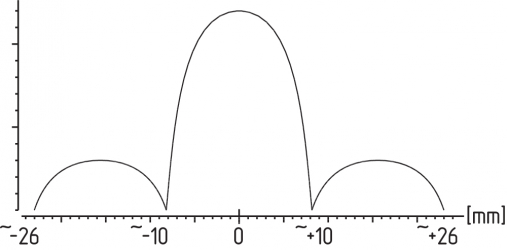 | 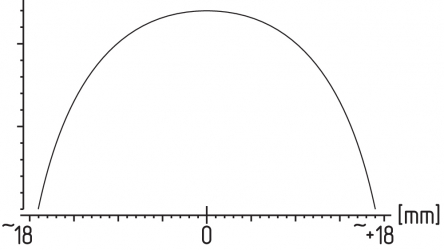 |
 |  |
- La dirección de aproximación sólo puede ser desde la dirección X e Y.
- Es obligatorio respetar la distancia de máx. 7 mm entre actuador y dispositivo de bloqueo, para poder alcanzar la fuerza de bloqueo indicada y la función de bloqueo seguro de SIL 3. El resguardo de seguridad debe estar diseñado de tal manera que no sea posible desplazar el resguardo de seguridad con el actuador en dirección del eje Z tanto que la distancia entre el dispositivo de bloqueo y el actuador sea superior a 7 mm.
- El diseño del dispositivo de seguridad debe ser tal que no exista riesgo de aplastamiento durante el desplazamiento del perno.
Montaje de los actuadores
Véase el manual de instrucciones del actuador correspondiente.
Para evitar cualquier variación del sistema y la reducción de las distancias de detección, se recomienda atender las siguientes recomendaciones:
- La existencia de piezas de metal y campos magnéticos cerca del actuador y del dispositivo de bloqueo por solenoide puede influir sobre la distancia de conmutación y tener como consecuencia fallos de funcionamiento
- Evitar todo tipo de virutas metálicas.
Distancia mínima entre dos dispositivos de bloqueo
o respecto a otros sistemas con la misma frecuencia (125 kHz): 30 mm.
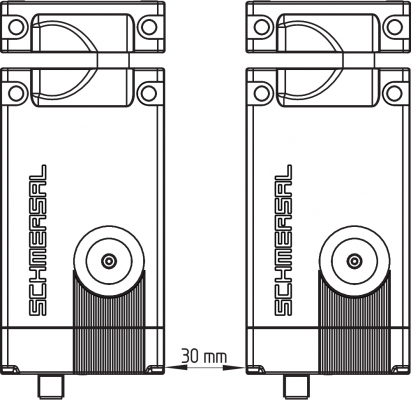 | 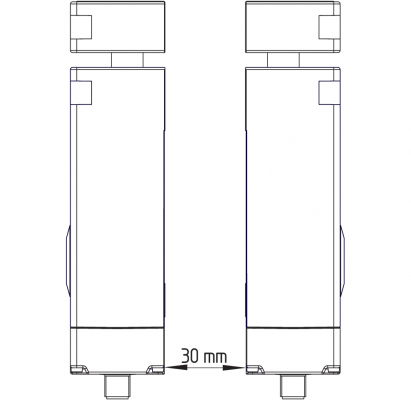 |
3.2 Desbloqueo manual
Para la colocación de la máquina se puede desbloquear el dispositivo de bloqueo estando libre de tensión. El dispositivo de bloqueo se desbloquea girando el rearme manual a la posición q con ayuda de la llave triangular. Sólo después de girar nuevamente el rearme manual a su posición inicial p se vuelve a la función normal.
La llave triangular TK-M5 (101100887) está disponible como accesorio.
- En el diseño se puede incluir la indicación mediate los LEDs (tres LEDs parpadeando) de un rearme manual adicional después de girar el rearme manual a su posición inicial. Estos son reseteados a través de las entradas de control tras una nueva activación.
- No girar el rearme manual más alla del tope.
| Posición bloqueada | Posición desbloqueada |
|---|---|
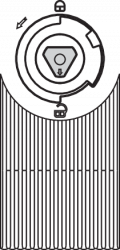 |  |
3.3 Desbloqueo manual eléctrico E (para ST 2)
El desbloqueo manual eléctrico se puede realizar a través de una alimentación de tensión auxiliar adicional. Para ello se dispone de la entrada de alimentación auxiliar H1.
Para que el perno de bloqueo regrese a su posición inicial independientemente de las entradas de control es necesario conectar el AZM400 solamente con la alimentación auxiliar.
A continuación no serán posibles más acciones adicionales, ya que las salidas de seguridad y de diagnóstico permanecerán desconectadas.
Estado del sistema (sólo válido durante la fase de inicialización):
| Alimentación principal | Alimentación auxiliar | Estado del sistema |
|---|---|---|
| 0 V | 0 V | Perno de bloqueo permanece en posición (salidas de seguridad desconectadas) |
| 24 V | 0 V | depende de las entradas de control |
| 0 V | 24 V | Perno de bloqueo regresa automáticamente a posición inicial (desbloquear) |
| 24 V | 24 V | Perno de bloqueo permanece en posición (error) |
- El cableado y el control del desbloqueo manual eléctrico debe someterse a una validación técnica de seguridad. La señal de la alimentación auxiliar a través de SAI es procesada internamente de manera distinta, de forma que no se reconocen cortocircuitos.
3.4 Desbloqueo de emergencia (anti-pánico) -T
Desbloqueo de escape para el uso dentro de la zona de peligro
Para el desbloqueo de emergencia (anti-pánico), girar la palanca roja en dirección de la flecha hasta el tope. El perno se desplaza con fuerza de resorte hacia la posición de desbloqueo, por lo que es posible abrir el resguardo de seguridad y las salidas de seguridad se desconectan. En posición desbloqueada, el resguardo de seguridad está protegido contra un bloqueo involuntario.
- ¡No girar más allá del tope!
| Posición bloqueada | Posición desbloqueada |
|---|---|
 |  |
- Para poder garantizar un funcionamiento correcto del desbloqueo anti-pánico -T, el resguardo de seguridad no debe encontrarse en un estado de tensión mecánica.
3.5 Montaje con grupo de montaje
Para perfiles de aluminio de 40 mm se puede utilizar el grupo de montaje opcional MS-AZM400. Este consta de dos placas de montaje, cuatro tornillos y cuatro tuercas.

3.6 Dimensiones
Todas las medidas en mm.

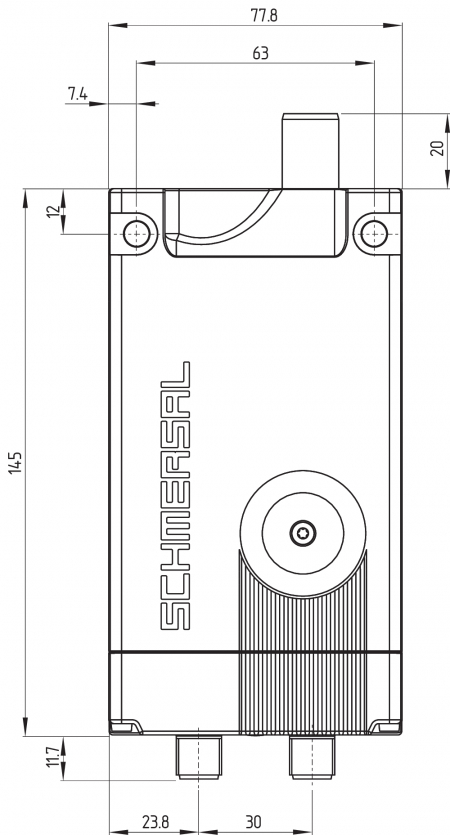
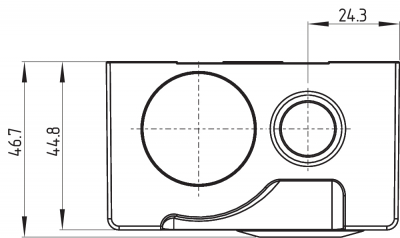
AZM 400 con desbloqueo de emergencia
| AZM400Z-ST..-T | AZM400Z-ST2..-T |
|---|---|
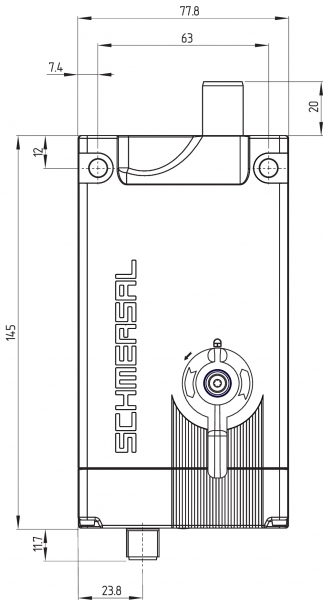 | 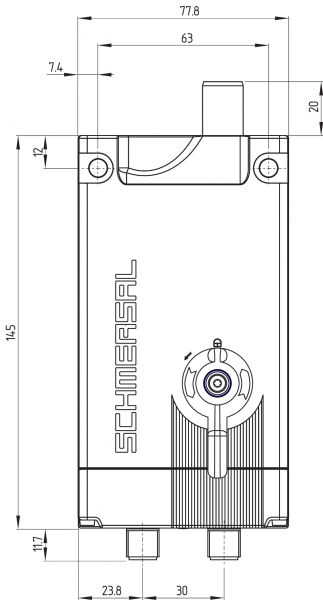 |
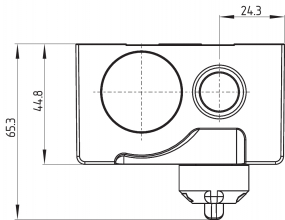 |
| Leyenda | |
|---|---|
| A1 | Desbloqueo manual con tapa |
| A2 | Dispositivo de desbloqueo de escape |
| B | Perno de bloqueo (posición salida) |
| C1 | Conector M12, 8-polos |
| C2 | Conector M12, 5-polos |
| D | Sensor RFID |
3.7 Actuadores y accesorios
Actuador AZM400-B1 (no incluido en el suministro)

Placa de montaje, pieza incluida en el grupo de montaje MS-AZM400
(disponible como accesorio)
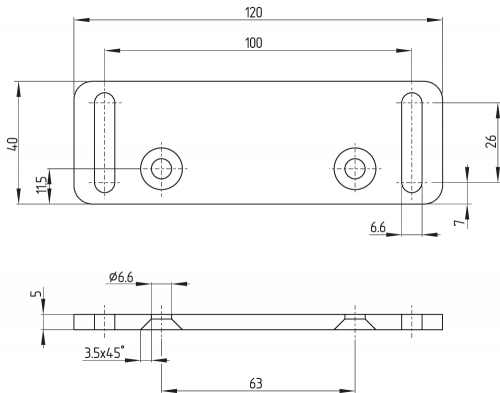
Pieza de bloqueo SZ400
(disponibles como accesorio)
Encontrará información detallada e instrucciones para el montaje en el manual de instrucciones del SZ400

Desbloqueo por cable Bowden ACC-AZM400-BOW-.M-.M
(disponible como accesorio)
Deberán observarse las instrucciones adicionales que se encuentran en el manual de instrucciones para el desbloqueo por cable Bowden.

4 Conexión eléctrica
4.1 Instrucciones generales para la conexión eléctrica
- La conexión eléctrica sólo debe realizarse estando el dispositivo libre de tensión y por personal experto autorizado.
Las entradas de tensión A1 (y H1 en el AZM400Z-ST2), así como las entradas de control E1, E2 y E3 deben estar protegidas contra sobretensión Deben utilizarse fuentes de alimentación PELV según EN 60204-1.
Las salidas de seguridad se pueden conectar directamente a la parte relativa a la seguridad del circuito de control.
En la instalación debe preverse la correspondiente protección de cables y fusible del equipo.
4.2 Posibilidades de control en modo operativo normal
Debido a las tres entradas de control E1, E2 y E3 para el control de la función de bloqueo, es posible utilizar diversas opciones de control, para poder operar el AZM400 en distintos controles de seguridad. La función de las entradas de control es la misma para ambas variantes ST y ST2. La activación de las entradas de control según la siguiente tabla, durante el funcionamiento, tiene como consecuencia el desbloqueo del dispositivo de bloqueo.
| Estado de la entrada | Variante P/P | Variante P/N | |||
|---|---|---|---|---|---|
| E1 | E2 | E3 | E1 = E2 | E3 | |
| Bloquear | abierto | abierto | GND | abierto | abierto |
| Desbloquear | 24 V | 24 V | GND | 24 V | GND |
Uso de salidas de seguridad del tipo P/P:
control (PLC) de seguridad

Uso de PLCs de seguridad del tipo P/N:
control (PLC) de seguridad

- Las salidas del PLC utilizadas deben cumplir con el nivel de prestaciones (PL) necesario en el resguardo de seguridad. Para lograr el PL, el PLC debe disponer de salidas comprobadas, ya que el AZM400 no realiza pruebas propias.
- Independientemente de la variante utilizada deberán observarse las instrucciones del manual del PLC utilizado.
Estas pueden ser, por ejemplo:
- Cables colocados de forma protegida
- Intervalo de prueba mínimo cada 24 horas
- etc.
Avance bloqueado
Cuando el perno de bloqueo no alcanza el estado "bloqueado" en el primer intento, el AZM400 realiza un segundo intento de forma autónoma. Si el segundo intento también falla, el AZM400 informa de un fallo (ver Tabla 2).
Después de un fallo es necesario un cambio de estado en las entradas de control para que el perno de bloqueo vuelva a salir.
Si el resguardo de seguridad es cerrado lentamente, puede ocurrir un avance bloqueado,si la apertura del actuador aún no se encuentra delante del perno que está saliendo (v. capítulo "Direcciones de accionamiento y distancias de conmutación").
Desbloqueo tras el encendido
Si el AZM400 ya se encuentra en posición de bloqueo después del encendido, el dispositivo debe primero desbloquearse y bloquearse de nuevo para comprobar la causalidad de las señales de control y la correcta profundidad de penetración del perno de bloqueo. Después de un encendido en posición bloqueada el LED amarillo parpadea.
4.3 Requisitos para una evaluación posterior
Entrada de seguridad de dos canales, adecuada para 2 salidas de semiconductor tipo p (OSSD)
Los dispositivos de bloqueo comprueban sus salidas de seguridad a través de desconexiones cíclicas. No es necesario el reconocimiento de cortocircuitos entre hilos en el relé de seguridad. Los tiempos de impulsos de prueba de ≤ 0,4 ms deben ser tolerados por el relé de seguridad. Los tiempos de impulsos de prueba de los dispositivos de bloqueo se incrementan adicionalmente dependiendo de la longitud y de la capacidad del cable utilizado.
- Configuración del PLC de seguridad
Al conectar el dispositivo de bloqueo de seguridad a relés de seguridad electrónicos recomendamos configurar un tiempo de discrepancia de 100 ms. Las entradas de se. guridad del relé deben ser capaces de ocultar un impulso de prueba de aprox. 1 ms.
- Encontrará información para la selección de los relés de seguridad adecuados en los catálogos de Schmersal, así como en el catálogo online disponible en products.schmersal.com.
4.4 Conexionado y conectores accesorios
Conexionado de la variante AZM400Z-ST-...
| Función dispositivo de seguridad | Asignación de los PIN's del conector empotrado M12. 8-polos | Código de color de los conectores Schmersal según DIN 47100 | Posible código de colores de otros conectores disponibles en el mercado según EN 60947-5-2Local | |
|---|---|---|---|---|
 | ||||
| A1 | UB | 1 | WH (blanco) | BN (marrón) |
| E1 | Entrada de control 1 | 2 | BN (marrón) | WH (blanco) |
| A2 | GND | 3 | GN (verde) | BU (azul) |
| Y1 | Salida de seguridad 1 | 4 | YE (amarillo) | BK (negro) |
| OUT | Salida de diagnóstico | 5 | GY (gris) | GY (gris) |
| E3 | Entrada de control 3 | 6 | PK (rosa) | PK (rosa) |
| Y2 | Salida de seguridad 2 | 7 | BU (azul) | VT (violeta) |
| E2 | Entrada de control 2 | 8 | RD (rojo) | OR (naranja) |
Conexionado de la variante AZM400Z-ST2-...
| Función dispositivo de seguridad | Asignación de los PIN's del conector empotrado M12, 8-polos | Código de color de los conectores Schmersal según DIN 47100 | Posible código de colores de otros conectores disponibles en el mercado según EN 60947-5-2Local | |
|---|---|---|---|---|
 | ||||
| OUT 2 | Salida de diangóstico 2 | 1 | WH (blanco) | BN (marrón) |
| E1 | Entrada de control 1 | 2 | BN (marrón) | WH (blanco) |
| - | (no conectado) | 3 | GN (verde) | BU (azul) |
| Y1 | Salida de seguridad 1 | 4 | YE (amarillo) | BK (negro) |
| OUT 1 | Salida de diangóstico 1 | 5 | GY (gris) | GY (gris) |
| E3 | Entrada de control 3 | 6 | PK (rosa) | PK (rosa) |
| Y2 | Salida de seguridad 2 | 7 | BU (azul) | VT (violeta) |
| E2 | Entrada de control 2 | 8 | RD (rojo) | OR (naranja) |
| Función dispositivo de seguridad | Asignación de los PIN's del conector empotrado M12, 5-polos | Código de color de los conectores Schmersal según DIN 47100 | Posible código de colores de otros conectores disponibles en el mercado según EN 60947-5-2Local | |
|---|---|---|---|---|
 | ||||
| A1 | UB | 1 | BN (marrón) | WH (blanco) |
| H2 | GNDhe | 2 | WH (blanco) | BN (marrón) |
| A2 | GND | 3 | BU (azul) | GN (verde) |
| H1 | Uhe | 4 | BK (negro) | YE (amarillo) |
| FE | Tierra funcional 3 | 5 | GY (gris) | GY (gris) |
Accesorios cables de conexión
| Cables de conexión con conector (hembra) M12, 8-polos – 8 x 0,25 mm², IP67 / IP69 | |
|---|---|
| Longitud del cable | Nº artículo |
| 2,5 m | 103011415 |
| 5,0 m | 103007358 |
| 10,0 m | 103007359 |
| 15,0 m | 103011414 |
| Cables de conexión con conector hembra M12, 5-polos – 5 x 0,34 mm² | |
|---|---|
| Longitud del cable | Nº artículo |
| 5,0 m | 103010816 |
| 10,0 m | 103010818 |
Bajo solicitud hay disponibles más versiones en distintas longitudes y salida de cables acodada
4.5 Ejemplos de conexión
Los ejemplos de aplicación mostrados son propuestas por lo que el usuario deberá comprobar que las conexiones sean realmente adecuadas para cada caso individual.
Ejemplo de conexión 1: AZM400Z-ST

| Leyenda conexionado | |
|---|---|
| Conector M12, 8-polos | |
| A1 | UB |
| A2 | GND |
| E1 | Entrada de control 1 |
| E2 | Entrada de control 1 |
| E3 | Entrada de control 2 |
| Y1 | Salida de seguridad 1 |
| Y2 | Salida de seguridad 2 |
| OUT | Salida de diagnóstico |
Ejemplo de conexión 2: AZM400Z-ST2
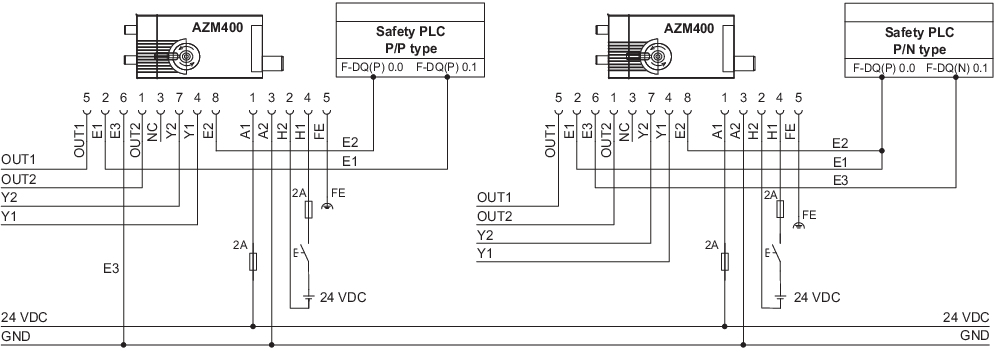
| Leyenda conexionado | |||
|---|---|---|---|
| Conector M12, 8-polos | Conector M12, 5-polos | ||
| E1 | Entrada de control 1 | A1 | UB |
| E2 | Entrada de control 2 | A2 | GND |
| E3 | Entrada de control 3 | H1 | Uhe |
| Y1 | Salida de seguridad 1 | H2 | GNDhe |
| Y2 | Salida de seguridad 2 | FE | Tierra funcional |
| OUT 1 | Salida de diangóstico 1 | ||
| OUT 2 | Salida de diangóstico 2 | ||
5 Aprendizaje de los actuadores / detección de actuador
Los dispositivos de bloqueo con codificación estándar están listos para funcionar en el momento de su entrega.
Los dispositivos de bloqueo y actuadores con codificación individual deben aprendizados entre ellos de la siguiente manera:
- Desconectar el dispositivo de bloqueo y aplicarle tensión nuevamente.
- Llevar el actuador a la zona de detección. El procedimiento de aprendizaje se indica en el dispositivo de bloqueo, el LED verde se apaga, el LED rojo se enciende y el LED amarillo parpadea (1 Hz).
- Tras 10 segundos el equipo solicita mediante breves impulsos parpadeantes (3 Hz) la desconexión de la tensión operativa del dispositivo de bloqueo. (Si no se desconecta en un plazo de 5 minutos, el dispositivo de bloqueo interrumpe el proceso de aprendizaje y comunica la existencia de un actuador equivocado parpadeando 5 veces en color rojo.)
- Tras la siguiente conexión de la tensión operativa el actuador debe programarse nuevamente para activar el código de actuador que se ha aprendido/programado. De esta manera el código activado se guarda definitivamente.
En la opción de pedido "I1" la asignación de sensor de seguridad y actuador así definida es irreversible.
En la opción de pedido -I2 el proceso de aprendizaje de un nuevo actuador se puede repetir ilimitadamente. Al realizar el aprendizaje de un nuevo actuador, el código utilizado hasta ese momento es invalidado. A continuación, una habilitación del bloqueo durante 10 minutos garantiza una mayor protección contra la neutralización/manipulación. El LED verde parpadea hasta que haya finalizado el tiempo de habilitación y se haya registrado el nuevo actuador. caso de interrupción de la alimentación de tensión durante el tiempo de habilitación, los 10 minutos de tiempo de protección contra la neutralización/manipulación empezarán nuevamente en cuanto se restablezca la tensión.
- Si se utiliza una variante con codificación estándar, recomendamos tomar medidas organizativas contra una posible neutralización/manipulación con otros elementos actuadores.
6 Principio activo y Funciones de diagnóstico
6.1 Funcionamiento de las salidas de seguridad
En el dispositivo de bloqueo de seguridad AZM400, la señal de desbloqueo desconecta inmediatamente las salidas de seguridad. El resguardo de seguridad desbloqueado puede volverse a bloquear mientras el actuadorse encuentre dentro del rango de registro del dispositivo de bloqueo de seguridad. A continuación las salidas de seguridad vuelven a conectarse.
En salidas de seguridad que ya están conectadas, los errores que no ponen en peligro inmediato el funcionamiento seguro del dispositivo de bloqueo (p.ej. temperatura ambiente demasiado elevada, salida de seguridad en potencial extraño, corto circuito entre hilos) tienen como consecuencia un mensaje de advertencia, la desconexión de la salida de diagnóstico OUT de la variante ST o resp. OUT 2 de la variante ST2, y el retardo de la desconexión de las salidas de seguridad. Las salidas de seguridad se desconectan cuando la advertencia de error persiste durante 30 minutos. Esta combinación de señales, salida de diagnóstico OUT de la variante ST o OUT 2 de la variante ST2 desconectada y salidas de seguridad conectadas aún, puede utilizarse para llevar a la máquina a una posición de parada ordenada. Una vez eliminado el error, el mensaje de error se cancela abriendo y cerrando el resguardo de seguridad correspondiente y/o desconectando y conectando nuevamente la tensión operativa.
6.2 LED's de diagnóstico
El dispositivo de bloqueo señaliza el estado de operación, así como posibles fallos, a través de tres LED's de distintos colores.
| verde (Power) | Tensión de alimentación disponible |
| amarillo (Estado) | condicion operativa |
| rojo (fallo) | Error (v. Tabla 2: Mensajes de error / Códigos de parpadeo del LED de diagnóstico rojo) |
| Posicionamiento de los LEDs | |
|---|---|
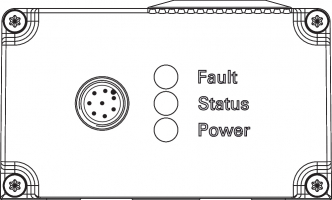 | 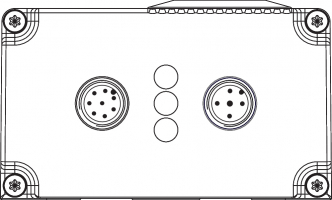 |
6.3 Salidas de diagnóstico
La salida de diagnóstico OUT, o resp. OUT 1 y OUT 2 para la variante ST2, protegida contra cortocircuitos, puede ser utilizada para indicaciones centralizadas o tareas de control, como por ejemplo en un PLC. Ella indica el estado de conmutación según se indica en la tabla 1.
¡Las salidas de diagnóstico OUT o resp. OUT 1 y OUT 2 no son salidas relevantes para la seguridad!
Error
Los errores que ya no garantizan el funcionamiento seguro del dispositivo de bloqueo (errores internos), tienen como consecuencia la desconexión de las salidas de seguridad. Un error que no ponga en peligro inmediato el funcionamiento seguro de un dispositivo de bloqueo (p.ej. temperatura ambiente demasiado alta, salida de seguridad en potencial extraño, cortocircuito entre hilos) tiene como consecuencia el retardo de la desconexión (véase la tabla 2). Una vez eliminado el error, el mensaje de error se cancela abriendo el resguardo de seguridad correspondiente.
Los errores en las entradas de control no tienen como consecuencia la desconexión de las salidas de seguridad.
Advertencia de error
Ha aparecido un error, que después de 30 minutos tiene como consecuencia la desconexión de las salidas de seguridad (el LED rojo "error" parpadea, v. tabla 2). Las salidas de seguridad, de momento (máx. 30 minutos), permanecen conectadas. Esto sirve para la desconexión controlada del proceso. La advertencia de error es retirada al eliminar la causa del error.
6.4 Información de diagnóstico
| Tabla 1: Información de diagnóstico del dispositivo de bloqueo por solenoide AZM 400 | ||||||||
|---|---|---|---|---|---|---|---|---|
| Estado del sistema | Señales de control | LED | Salidas de seguridad | Salidas de diagnóstico | ||||
| Función de bloqueo | verde | rojo | amarillo | Y1, Y2 | Variante ST OUT | Variante ST2 OUT1 | Variante ST2 OUT2 | |
| Resguardo abierto y desbloqueado (perno retirado) | Desbloquear | encendido | apagado | apagado | 0 V | 0 V | 0 V | 0 V |
| Resguardo cerrado y desbloqueado (perno retirado) | Desbloquear | encendido | apagado | parpadea | 0 V | 24 V | 0 V | 0 V |
| Resguardo cerrado, proceso de bloqueo activo (perno en movimiento hacia adelante) | Bloquear | encendido | apagado | parpadea | 0 V | 0 V | 0 V | 24 V |
| Resguardo cerrado y bloqueado (perno salido) | Bloquear | encendido | apagado | encendido | 24 V | 24 V | 24 V | 24 V |
| Resguardo cerrado, proceso de desbloqueo activo (perno en movimiento de retroceso) | Desbloquear | encendido | apagado | parpadea | 0 V | 0 V | 24 V | 24 V |
| Estados de error: | ||||||||
| Advertencia de error 1) | Sin importancia | encendido | parpadea 2) | encendido | 24 V | 0 V | 24 V | 0 V |
| Error | Sin importancia | encendido | parpadea 2) | apagado | 0 V | 0 V | 24 V | 0 V |
| Desbloqueo mecánico auxiliar, de emergencia o por cable de tracción (Bowden) activo | Sin importancia | parpadea | parpadea | parpadea | 0 V | 24 V | 0 V | 24 V |
| Desbloqueo manual electrónico activo | Sin importancia | parpadea | parpadea | parpadea | 0 V | - | 0 V | 0 V |
| Aprendizaje de los actuadores en la versión I1/I2: | ||||||||
| Aprendizaje del actuador iniciado | Desbloquear | apagado | encendido | parpadea lentamente | 0 V | 0 V | 0 V | 0 V |
| El aprendizaje del actuador puede finalizar | Desbloquear | apagado | encendido | parpadea rápido | 0 V | 0 V | 0 V | 0 V |
| Sólo I2: El actuador está emparejado (tiempo de protección contra neutralización/manipulación en marcha) | Desbloquear | parpadea | apagado | apagado | 0 V | 24 V | 0 V | 24 V |
1) después de 30 min: desconexión por error 2) v. código de parpadeo | ||||||||
| Tabla 2: Mensajes de error / Códigos de parpadeo del LED de diagnóstico rojo | |||
|---|---|---|---|
| Códigos de parpadeo (rojo) | Denominación | desconexión autónoma tras | Motivo del error |
| 1 parpadeo | (Advertencia de) error en la salida Y1 | 30 min | Error en la comprobación de salida o tensión en la salida Y1, a pesar de que la salida está desconectada |
| 2 parpadeos | (Advertencia de) error en la salida Y2 | 30 min | Error en la comprobación de salida o tensión en la salida Y2, a pesar de que la salida está desconectada |
| 3 parpadeos | (Advertencia de) error por cortocircuito entre hilos | 30 min | Cortocircuito entre los cables de salida o error en ambas salidas |
| 4 parpadeos | (Advertencia de) error por sobretemperatura | 30 min | La medición de temperatura da una temperatura interior demasiado alta |
| 5 parpadeos | Error actuador | 0 min | Actuador erróneo o defectuoso |
| 6 parpadeos | Error entradas control / desbloqueo manual electrónico | - | Estados no válidos de las entradas de control y/o del desbloqueo manual electrónico |
| 7 parpadeos | Error en la detección del actuador | 0 min | Distancia entre AZM400 y actuador demasiado grande; campos magnéticos externos impiden la detección |
| 8 parpadeos | Error avance bloqueado | 0 min | Actuador no alineado correctamente respecto al dispositivo de bloqueo |
| 9 parpadeos | Error sobre/subtensión | 0 min | Tensión de alimentación fuera de las especificaciones |
| Rojo constante | Error interno | 0 min | Equipo defectuoso |
| Tabla 2.1: Mensajes de error/códigos de parpadeo, LED amarillo | |||
|---|---|---|---|
| Códigos de parpadeo (amarillo) | Denominación | desconexión autónoma tras | Motivo del error |
| Parpadeo rápido amarillo (2 Hz) | Error entradas de control | 0 min | Frecuencia demasiado alta (> 0,3 Hz) en las entradas de control E1 y E2 |
7 Puesta en servicio y mantenimiento
7.1 Prueba de funcionamiento
Debe comprobarse el funcionamiento correcto del dispositivo de seguridad. Debe asegurarse lo siguiente:
- Comprobar el desplazamiento lateral máx. de la unidad de actuador y el dispositivo de bloqueo.
- Comprobar el desplazamiento angular máx.
- Asegurar que sea imposible elevar el actuador sentido del eje Z más allá del perno extendido.
- Comprobar que el actuador y el dispositivo de bloqueo por solenoide de seguridad estén montados correctamente.
- Los cables de conexión deben estar en perfecto estado.
- Comprobar que la caja del interruptor no esté dañada
- Eliminar suciedad
- Para las variantes con desbloqueo de emergencia (anti-pánico) debe tenerse en cuenta además:
Debe ser posible abrir el resguardo de seguridad desde dentro de la zona de peligro y no debe ser posible bloquear el resguardo de seguridad desde dentro.
7.2 Mantenimiento
Si está correctamente instalado y se utiliza de la manera prevista, el interruptor no requiere de mantenimiento.
Recomendamos realizar regularmente una inspección visual y una prueba de funcionamiento, siguiendo los pasos que se indican a continuación:
- Comprobar que el actuador y el dispositivo de bloqueo por solenoide de seguridad estén montados correctamente.
- Comprobar el desplazamiento lateral máx. de la unidad de actuador y el dispositivo de bloqueo.
- Comprobar el desplazamiento angular máx.
- Asegurar que sea imposible elevar el actuador sentido del eje Z más allá del perno extendido.
- Los cables de conexión deben estar en perfecto estado.
- Comprobar que la caja del interruptor no esté dañada
- Eliminar suciedad
- En todas las fases de vida de funcionamiento del dispositivo de seguridad deberán tomarse las medidas constructivas y organizativas necesarias para la protección contra la neutralización/manipulación o evasión del dispositivo, como por ejemplo mediante la instalación de un actuador de reserva.
- Los equipos dañados o defectuosos se deberán sustituir.
8 Desmontaje y retirada
8.1 Retirada
El dispositivo de seguridad sólo debe desmontarse estando libre de tensión.
8.2 Retirada
- El interruptor de seguridad se debe retirar de forma adecuada cumpliendo las normas y leyes nacionales.
| UK Declaration of Conformity |  |
| Company: | K.A. Schmersal GmbH & Co. KG Möddinghofe 30 42279 Wuppertal Germany Internet: www.schmersal.com |
| Declaration: | We hereby, under sole responsibility, certify that the hereafter described components both in their basic design and construction conform to the relevant statutory requirements, regulations and designated standards of the United Kingdom. |
| Name of the component: | AZM400 |
| Type: | See ordering code |
| Description of the component: | Interlocking device with safe locking function |
| Relevant legislation: | Supply of Machinery (Safety) Regulations | 2008 |
| Radio Equipment Regulations | 2017 | |
| The Restriction of the Use of Certain Hazardous Substances in Electrical and Electronic Equipment Regulations | 2012 |
| Designated standards: | EN 60947-5-3:2013 EN ISO 14119:2013 EN 300 330 V2.1.1:2017 EN ISO 13849-1:2015 IEC 61508 parts 1-7:2010 |
| Approved body for Type Examination: | TÜV Rheinland UK Ltd. 1011 Stratford Road Solihull, B90 4BN ID: 2571 |
| Type examination certificate: | 01/205U/5467.00/22 |
| UK-Importer / Person authorised for the compilation of the technical documentation: | Schmersal UK Ltd. Paul Kenney Unit 1, Sparrowhawk Close Enigma Business Park Malvern, Worcestershire, WR14 1GL |
| Place and date of issue: | Wuppertal, September 23, 2022 |
 |
| Authorised signature Philip Schmersal Managing Director |
| Declaración de conformidad CE |  |
| Original | K.A. Schmersal GmbH & Co. KG Möddinghofe 30 42279 Wuppertal Alemania Internet: www.schmersal.com |
| Declaración: | Por el presente documento declaramos que debido a su concepción y tipo de construcción, las piezas relacionadas cumplen con los requisitos de las Directivas Europeas que se indican a continuación. |
| Denominación del producto: | AZM 400 |
| Modelo: | ver código de pedidos |
| Descripción de la pieza: | Dispositivo de enclavamiento con función de bloqueo seguro |
| Directivas aplicables: | Directiva de Máquinas | 2006/42/CE |
| Directiva RED | 2014/53/CE | |
| Directiva RoHS | 2011/65/CE |
| Normas aplicadas: | EN 60947-5-3:2013 EN ISO 14119:2013 EN ISO 14119:2025 EN 300 330 V2.1.1:2017 EN ISO 13849 parte 1-7:2010 |
| Entidad designada para la homologación de tipo: | TÜV Rheinland Industrie Service GmbH Am Grauen Stein, 51105 Köln Certif. núm.: 0035 |
| Certificación de homologación de tipo CE: | 01/205/5467.02/25 |
| Responsable de la recopilación de la documentación técnica: | Oliver Wacker Möddinghofe 30 42279 Wuppertal |
| Lugar y fecha de emisión: | Wuppertal, 12 de agosto de 2025 |
 |
| Firma legal Philip Schmersal Director General |
Schmersal Ibérica, S.L., Rambla P. Catalanes, Nº 12, 08800 Vilanova i la Geltrú
Los datos e información anteriores se han verificado cuidadosamente. Las imágenes pueden diferir del original. Se pueden encontrar más datos técnicos en los manuales de instrucciones. Sujeto a cambios técnicos y errores.
Generado a 20/9/2025 18:01
.png?id=3f3339435fb0327df6974792fc349718)
